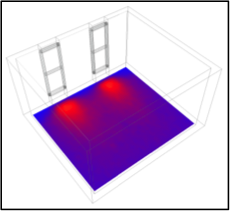Healthy Homes: Let There Be [Day] Light
Modern design trends are placing comfort and health at risk in the quest for affordability.
Building research think tank, CSR Innovation, has identified a trend in the housing market where building designers are opting for fewer and smaller windows in the mainstream housing market, limiting distribution of natural light and creating darkened spaces in homes. This is not simply resolved by switching on a few lights: international research has shown increased levels of natural daylight aids Vitamin D and Serotonin production. Both Vitamin D and Serotonin aids mental, spiritual and physical health, and studies show that reduced levels increases the incidence of depression, anxiety, ill health and even prolongs recovery from illness. Research has found:
- Natural light benefits mood and mental health
- Natural light aids recovery from illness
- Natural light has positive impacts on building occupants
- Natural light aids connection with the local environment
- Natural light increases the sense of space in a building
Since 2005 CSR Innovation has noted a reduction of the glazing ratios (window area to floor area) of project built homes across Australia. “Thousands of project built homes are now being built with glazing ratios of less than 18%, with many below 15%,” says Jesse Clarke, Building Scientist with CSR Innovation. While energy efficiency regulations in Australia are adequate in specifying insulation, window heat transfer and window solar heat transfers, they are lacking in defining the performance criteria to maximise the benefits of daylight. “The BCA permits glazing ratios as low as 10%,” adds Clarke. “However some builders have realised that consumers don’t want dark cavern-like rooms in their homes. “For many houses in tropical Australia an 18% glazing ratio may be sufficient due to more ambient daylight. As we move south, available light levels are reduced and buildings have lower natural daylight penetration,” Clarke advises. “Higher glazing ratios are needed in sub-tropical, temperate and cool climates.” Daylight penetration is influenced by room shape, window size, position and glazing treatment. Average daylight levels (at floor level) of 3% of available daylight (ideally ranging between 2.5% and 3.5%) are sufficient to provide a healthy spread of daylight. While this sounds easily achievable, in near-square shaped rooms with 15% glazing ratio (typically on one wall) CSR studies have shown uneven spread of daylight, up to 7.8% adjacent to the window – however the room average is as low as 2.1% with 87% area less than 3%.
 |
A single window tends to give a patch of light falling on the floor in front of the window. Large variance in daylight.
|
 |
Multiple and Smaller windows can help distribute the light more evenly in a room. Glare reduced but lower light.
|
 |
Adding a 2nd smaller window to adjacent wall provides a better spread of light. Suitable daylight but too glary.
|
 |
Distributing equally sized windows around the room provides a better spread of light.
|
All rooms = 14.4 square metres. All windows have equivalent performance values. When glazing ratios are increased to 22.5%, the average daylight level is increased to 3.1% with a more even spread of light. As shown in the daylight models (above) the number and placement of windows has a large influence on the available daylight. “Homeowners and occupants are missing out on access to natural light and creating spaces that feel dark and uncomfortable,” Clarke says. “Our research has shown that comfort is more than having a stable internal temperature. General occupant comfort is aided by natural light, acoustics and controllable ventilation, among other physiological inputs.” Suitable levels of daylight can be achieved cost effectively with a balanced design approach developed by CSR. “Building design must place equal importance on all general comfort aspects, ensuring the star rating is optimised while delivering daylight, acoustics and ventilation to the building occupants,” Clarke suggests. “Windows are key to enabling all aspects of comfort; so getting your window size, location and specification right is critical to the ongoing comfort provided by the building.” Based on research at CSR house in Schofields, NSW, daylight design rules have been developed to determine required glazed areas based on the zone in the house, glass type and window configuration. Planning window placement for daylight penetration is not an easy task, however attention should be provided to areas commonly used during the daytime.
CSR’s guidelines for glazing distribution include:
- Daytime use rooms should have glazing ratios 20% above the average for the whole house
- Other daytime use areas such as bathrooms, ensuites and corridors may have their glazing ratios 20% below the house average
- Bedrooms should have glazing ratios roughly equal to the house average
- Other night time use rooms such as rumpus rooms and home theatres may have their glazing ratios 20% below the house average
“Even if you over glaze a room by a small margin, you can always use shading to manage glare,” Clarke adds. “If your windows are too small the room will always be naturally dark.”
The Living Space is brought to you by Viridian New World Glass.
![Viridian Glass – Healthy Homes: Let There Be [Day] Light](https://www.viridianglass.com/wp-content/uploads/2024/01/wp-content-uploads-2014-10-viridianglass_eaglemonthouse_003.jpg)